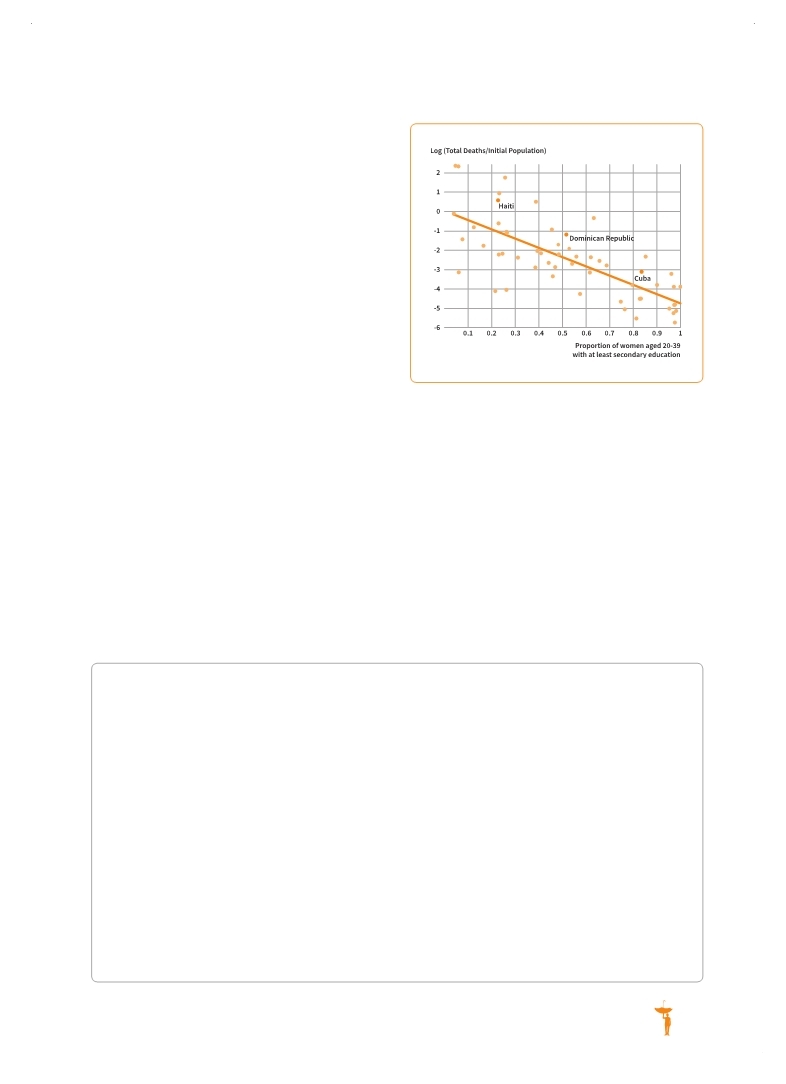 |
Global Assessment Report on Disaster Risk Reduction 2015
Making development sustainable: The future of disaster risk management |
 |
Global Assessment Report on Disaster Risk Reduction 2015
Making development sustainable: The future of disaster risk management |
|
|

139
Note: The graph shows deaths per 1,000 based on 1980 population levels (y-axis) proportional to secondary and higher education among women aged 20-39 (x-axis) for 56 countries with one or more disasters on average per annum.
(Source: Pichler and Striessnig, 2014
Pichler, Adelheid and Erich Striessnig. 2014,Dif-ferential Vulnerability to Hurricanes in Cuba, Haiti, and the Dominican Republic: The Contribution of Education, Ecology and Society, Vol. 18, No. 3: 31. doi: http://dx.doi.org/10.5751/ES-05774-180331.. . Figure 7.3 Weather-related disaster mortality and female education in Cuba, the Dominican Republic and Haiti
Box 7.4 Key activities related to education and training in the HFA
(h) Promote the inclusion of disaster risk reduction knowledge in relevant sections of school curricula at all levels and the use of other formal and informal channels to reach youth and children with information; promote the integration of disaster risk reduction as an intrinsic element of the United Nations Decade of Education for Sustainable Development (2005–2015).
(i) Promote the implementation of local risk assessment and disaster preparedness programmes in schools and institutions of higher education. (j) Promote the implementation of programmes and activities in schools for learning how to minimize the effects of hazards. (k) Develop training and learning programmes in disaster risk reduction targeted at specific sectors (development planners, emergency managers, local government officials, etc.). (l) Promote community-based training initiatives, considering the role of volunteers, as appropriate, to enhance local capacities to mitigate and cope with disasters. (m) Ensure equal access to appropriate training and educational opportunities for women and vulnerable constituencies; promote gender and cultural sensitivity training as integral components of education and training for disaster risk reduction. mortality from disasters (KC, 2013
K.C., Samir. 2013,Community Vulnerability to Floods and Landslides in Nepal, Ecology and Society, Vol. 18, No. 1: 8. doi: http://dx.doi. org/10.5751/ES- 05095-180108.. . While education in itself is critical to disaster risk reduction, the HFA proposed a number of key activities under Priority for Action 3 which relate specifically to the inclusion of disaster risk reduction in education and training (Box 7.4).
Since 2005, an abundance of educational materials in the form of guidelines, teacher’s guides and curriculum reform guides have been produced in various languages.3 However, the content and quality of educational materials on disaster risk reduction has not been seriously reviewed, and the uptake of the available materials by educational institutions is not monitored. As a result, it is difficult to assess what progress has been made, to what extent efforts in reforming curricula to include risk considerations have been successful, or where and why they may have failed.
The nature of curriculum development in itself makes it difficult for a framework like the HFA to exert strong influence on the decision-making process. On the one hand, curricula are reviewed and adapted in 5 to 10-year cycles, which may not
|
 
Page 1Page 10Page 20Page 30Page 40Page 50Page 60Page 70Page 80Page 90Page 100Page 110Page 120Page 129Page 130Page 131Page 132Page 133Page 134Page 135Page 136Page 137Page 138Page 139Page 140->Page 141Page 142Page 143Page 144Page 145Page 146Page 147Page 148Page 149Page 150Page 151Page 152Page 153Page 160Page 170Page 180Page 190Page 200Page 210Page 220Page 230Page 240Page 250Page 260Page 270Page 280Page 290Page 300Page 310
|
|
 
|
 
|
